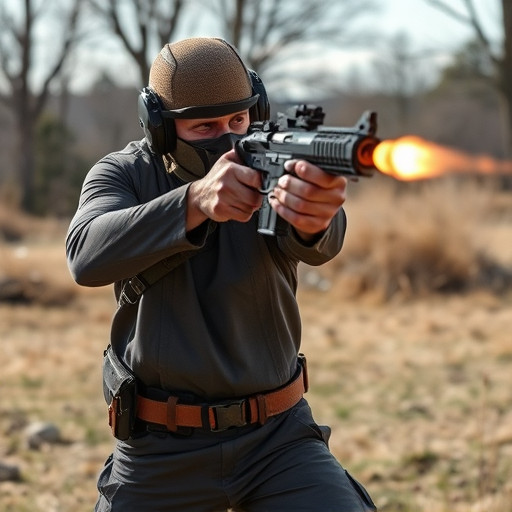How to Charge Stun Gun: Understanding Voltage Penetration Through Thick Clothing
Voltage interaction with materials, crucial for stun gun effectiveness, is influenced by conductivit…….
Voltage interaction with materials, crucial for stun gun effectiveness, is influenced by conductivity and dielectric strength. Clothing's impact on voltage penetration varies by material, thickness, and moisture content. Proper charging techniques, per manufacturer instructions, are essential for optimal performance and safety when using stun guns. Thicker fabrics reduce voltage transmission, emphasizing the need for training, controlled environments, and understanding local laws for responsible stun gun use.
Voltage penetration through thick clothing is a critical aspect of understanding the effectiveness of stun guns. This article delves into the science behind voltage and its interaction with various materials, exploring factors that influence clothing’s electrical conductivity. We’ll guide you through proper stun gun charging techniques and essential safety measures when deploying them through thick fabric. Learn how to maximize impact while ensuring safe usage in challenging situations. For effective stun gun operation, follow these insights on optimal charging practices.
- Understanding Voltage and Its Behavior Through Materials
- Factors Affecting Clothing's Electrical Conductivity
- Proper Stun Gun Charging Techniques
- Safety Measures When Using Stun Guns Through Thick Fabric
Understanding Voltage and Its Behavior Through Materials

Voltage, a fundamental concept in electromagnetism, describes the potential difference between two points in an electric field. When it encounters different materials, its behavior can vary significantly, which is crucial to understanding how certain devices, like stun guns, operate and need to be properly charged. Materials’ electrical properties, such as conductivity and dielectric strength, play a pivotal role in determining voltage penetration.
For instance, low-conductivity materials like thick clothing or certain types of protective gear can impede the flow of electric current, reducing the effectiveness of high voltages. On the other hand, understanding these interactions is essential for designing devices like stun guns that require precise voltage delivery to ensure their functionality and safety during use. Proper charging techniques, therefore, involve considering not just the device’s specifications but also the materials it will encounter.
Factors Affecting Clothing's Electrical Conductivity

Clothing’s ability to conduct electricity, and thus its effectiveness in allowing voltage penetration, is influenced by several key factors. First and foremost, the material of the clothing plays a crucial role. Different fabrics have varying levels of electrical conductivity; for instance, metals like copper or aluminum are excellent conductors, while materials like cotton, wool, or synthetic fibers are insulators. The thickness of the fabric is another critical aspect; thicker garments generally present a higher resistance to electrical flow due to their increased material density.
Additionally, the presence of moisture can significantly impact conductivity. When wet, many fabrics become more conductive, as water molecules can facilitate the movement of electric charges. This is why it’s essential to consider proper drying when testing or charging devices like stun guns through clothing—ensuring the fabric is dry can help optimize voltage penetration for effective use.
Proper Stun Gun Charging Techniques

Properly charging your stun gun is an essential step in ensuring its effectiveness when you need it most. Start by understanding that different stun guns may have unique charging requirements, so always refer to the manufacturer’s instructions for specific guidance on your model. Typically, this involves using a standard USB cable to connect the device to a power source.
When charging, ensure the stun gun is turned off. This prevents any accidental activation during the charging process. Allow the device to charge fully, and remember that some models may have indicators or LED lights that show when it’s complete. Regular charging, as recommended by the manufacturer, will maintain optimal performance and prolong the lifespan of your stun gun, so establish a consistent charging routine for peace of mind.
Safety Measures When Using Stun Guns Through Thick Fabric

When considering safety measures while using a stun gun through thick fabric, it’s crucial to understand the limitations and potential risks involved. The effectiveness of a stun gun is significantly reduced when targeting individuals wearing heavy clothing due to the electrical current’s difficulty in penetrating the material. Therefore, users should be cautious not to rely solely on the device’s power; instead, focus on proper training, understanding the weapon’s reach, and ensuring safe operation.
To ensure safety, always follow instructions for how to charge a stun gun properly. This involves regular maintenance and checking of the device’s battery life. Additionally, users should be well-versed in the legal implications and restrictions surrounding stun guns in their area. Practice in controlled environments, like ranges, is essential to learn the proper technique, including target acquisition and trigger control, without endangering others. Remember, safe handling and responsible use are paramount when considering self-defense tools like stun guns.
When using a stun gun, understanding voltage penetration through thick clothing is crucial. By comprehending the behavior of voltage through various materials and the factors impacting clothing’s electrical conductivity, you can ensure safe and effective deployment. Adhering to proper charging techniques and implementing safety measures when targeting thick fabric will optimize the stun gun’s performance. Remember, knowledge is key; always follow recommended guidelines for both charging and usage to maintain effectiveness and mitigate risks.


